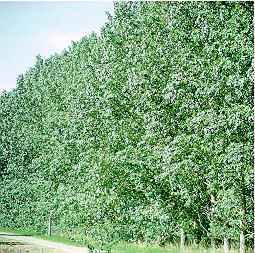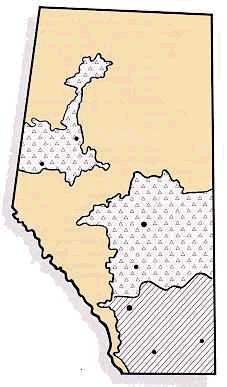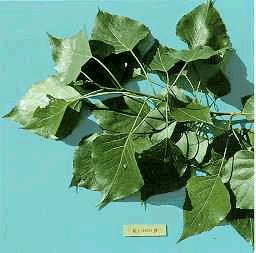| | Plant characteristics | Fall colour | Site preference | Hardiness | Uses | Problems | Diseases | Insects | Pruning
.

Scientific Name: Populus x 'Brooks #4' or 'Brooks #6'
Plant Characteristics
This poplar is presumed to be a cross between a native cottonwood and a Russian poplar (Populus deltoides x Populus x petrowskyana). It is a male clone introduced by Mr. A. Griffin, superintendent of the C.P.R.'s Engineering Division at Brooks, Alberta in 1954.
This poplar is a tall, fast-growing, upright, deciduous tree with rough bark. It carries its leaves fairly late in the year. Its mature height ranges from 10 to 25 m (33 to 80 ft) with a spread of about 15 m (50 ft). It can be expected to reach a height of 6 m (20 ft) in five to seven years from a one - year - old rooted cutting. Its useful life is between 15 and 30 years.
Leaves - Leaves are alternate, simple, dark shiny green, diamond-shaped.
Propagated by cuttings.
Fall Colour
Leaves - golden yellow.
Site Preference
Wide soil adaptation. Requires generous amounts of water, but will survive while exposed to short periods of low moisture.
Can be planted in full sun or half shade.
Hardiness
Northern Alberta. Tolerates early and late frosts.
.


Uses
For farmstead windbreaks, poplars should be planted in combination with a conifer. In shelterbelt situations it should be planted 2 to 4 m (6 to 13 ft) between trees in the row and 5 to 8 m (17 to 26 ft) between rows.
Brooks poplars are used for shade trees, accent plantings, street trees, parks plantings and shelterbelts. Too large for a normal city lot, but good for large properties and parks.
It is one of the two most desirable large male hybrid poplars in Alberta, the other one being Northwest poplar.
Problems
Extensive root system may spread up to four times the height of the tree. Roots may invade cracks in pavement, concrete and sewer lines, causing further damage. Roots will sucker if damaged.
Diseases
Canker - usually associated with a major setback e.g. transplanting, heavy pruning, root disturbance, old age, and/or drought.
Insects
Forest tent caterpillars. Poplar gall mites have been found on this plant only on rare occasions.
Pruning
Light spring pruning is preferred to remove dead, diseased or damaged branches. Usually allowed to develop multistems in shelterbelts.

Shelterbelts Varieties for Alberta provides information on a number of other trees and shrubs than may be suitable for shelterbelts.
Visit our website directory for the Reforestation Woodlot Listings.
|
|